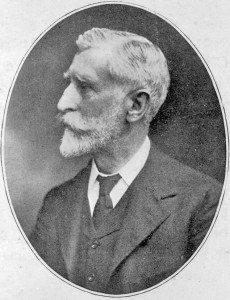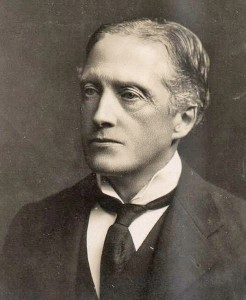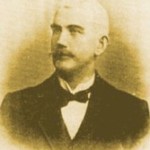
William Martin Murphy (1844 – 1919)
Newspaper baron, MP, builder and owner of the Dublin Tramway Company, William Martin Murphy led Dublin employers against Jim Larkin’s trade union movement.
In August 1913, he sacked hundreds of workers whom he suspected of union membership, leading to a strike and ultimately the locking out of the workers who refused to sign a pledge never to join a union. During the Lock-Out, Murphy made full use of the newspapers under his control to portray Jim Larkin as a villain. Several workers died during the dispute, and Murphy was often referred to as ‘William Murder Murphy’ by Dublin workers.
It must be said, however, that Murphy was a complex character, originally known for being a fair employer. Because of his nationalist politics, he dramatically refused to accept a knighthood from King Edward VII. During his early years in business in Dublin, he was invited by a building labourers’ union to – successfully – arbitrate a dispute, and was praised for his fairness by both sides. The Daily Chronicle in 1907 referred to him as ‘the iron hand in the velvet glove’.

The Earl of Iveagh (1847 – 1927)
Edward Guinness, Earl of Iveagh had become the wealthiest man in Ireland by floating the Guinness Company on the London Stock Exchange in 1886. He remained in control of the company and in 1913, was its chairman and biggest shareholder. Guinness was the largest employer and biggest exporter in Dublin in 1913. The company was an exemplary employer; providing housing, schools, hot meals, medical care and even cookery classes for its workers. Nonetheless, Guinness had a policy against sympathetic strikes, expecting its workers not to strike in the light of their excellent conditions. Lord Iveagh refused to join William Martin Murphy in locking out workers, but in October 1913, the Guinness company dismissed boat crews who were refusing to handle ‘tainted goods’ in the ports as it was unloaded using imported ‘scab labour’. Although a teetotaller, Jim Larkin rejected calls to boycott Guinness products. Larkin appealed unsuccessfully to have the workers reinstated.

Superintendent Fergus Quinn, Dublin Metropolitan Police (1881 – 1920)
Two men with similar backgrounds ended up on opposing sides in the Dublin Lock-Out: Jim Larkin and Fergus Quinn. Like Larkin, Quinn came from a working class background, starting life as a labourer. An Irish Nationalist and self-made man, by 1913 he had risen to the rank of superintendent in the DMP. The day before Bloody Sunday, Quinn had secured arrest warrants for both Larkin and Connolly.
Depending on which accounts you read, Bloody Sunday is an event which showed considerable police brutality, or a civic guard endangering their own lives to keep the peace: or both. Police historian Gregory Allen has written that the police in 1913 were ‘caught in the crossfire’ in the battle between the strikers and the employers.
In the end, despite serving the establishment for many years, Quinn was not rewarded for his long service. Although he became Joint Assistant Commissioner of the RIC in 1915, Quinn, like many other high-ranking Catholic nationalists in the police were forced to resign in 1920, apparently due to their nationalist sympathies.
From left: William Martin Murphy, Edward Guinness and Supt. Fergus Quinn.
By Ruth Kennedy

